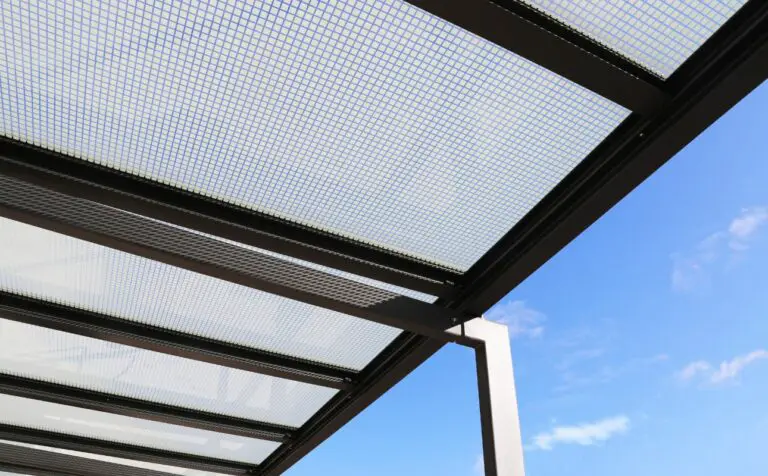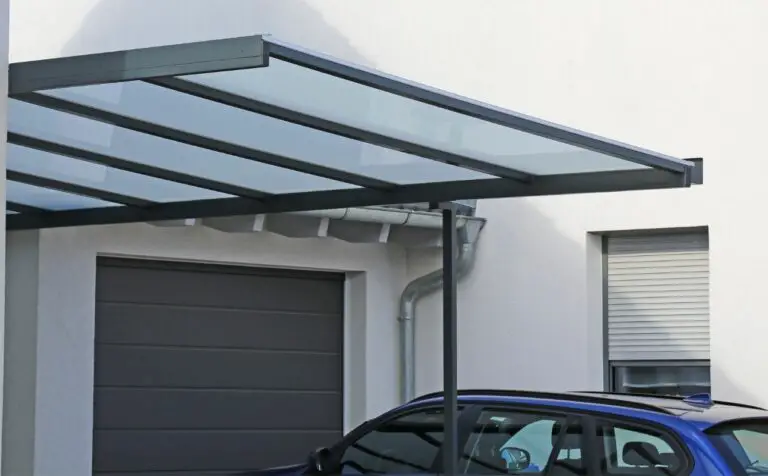Are Portable Carports Worth It? (Beginner’s Guide)
When considering options for vehicle protection and additional storage space, many individuals often wonder if portable carports are worth the investment. Portable carports, also known as temporary or mobile carports, offer a convenient and flexible solution for sheltering vehicles from the elements.
These structures typically consist of a frame supporting a metal or fabric canopy, providing a covered area for cars, trucks, RVs, or other recreational vehicles. However, before deciding whether portable carports are worth it, it is essential to evaluate their advantages, disadvantages, and suitability for individual needs.

The Benefits of Portable Carports
Portable carports offer several benefits that make them a popular choice for vehicle protection and storage. Here are some key advantages of portable carports:
- Affordability
Portable carports are often more cost-effective compared to constructing a permanent garage or carport. They provide a budget-friendly solution for individuals looking to protect their vehicles without the significant expense of a traditional structure.
- Easy Installation
One of the primary advantages of portable carports is their simple and quick installation process. These structures typically come in pre-fabricated kits that can be easily assembled with basic tools and minimal construction skills. They can be set up on various surfaces, such as concrete, gravel, or grass, making them highly versatile.
- Portability and Flexibility
As the name suggests, portable carports can be easily moved and relocated as needed. This flexibility is especially beneficial for renters or individuals who frequently change residences. Portable carports can be disassembled, transported, and reassembled at a new location, providing continuous protection for vehicles.
- Weather Protection
Portable carports offer effective protection against various weather conditions. The canopy or cover provides a shield against direct sunlight, preventing UV damage and keeping the interior of vehicles cooler. Additionally, the canopy helps to protect vehicles from rain, snow, hail, and other outdoor elements, extending their lifespan and maintaining their aesthetics.
- Versatile Usage
Portable carports are not limited to vehicles alone. They can also be used as additional storage space for other items, such as boats, motorcycles, bicycles, gardening equipment, or outdoor furniture. This versatility makes portable carports a practical solution for individuals with limited storage space or those seeking temporary shelter for various belongings.
- Minimal Footprint
Unlike permanent structures, portable carports typically have a smaller footprint. This makes them suitable for properties with limited space or where building regulations may restrict the construction of permanent structures. Portable carports can be easily adjusted in size to fit different spaces without significant modifications.
- Customization Options
Portable carports come in various sizes, styles, and designs, allowing individuals to choose one that suits their preferences and requirements. They can be customized with additional features like side panels, doors, or windows to enhance functionality and aesthetics.
The Drawbacks of Portable Carports
While portable carports offer several benefits, it is important to consider their drawbacks before making a decision. Here are some potential disadvantages of portable carports:
- Limited Security
Portable carports provide a level of protection for vehicles, but they do not offer the same level of security as enclosed garages. Since they are open structures, vehicles stored in portable carports may be more vulnerable to theft or vandalism compared to those kept in locked garages.
- Durability Concerns
While portable carports are designed to withstand various weather conditions, their durability may be lower compared to permanent structures. Harsh weather conditions such as strong winds or heavy snowfall can pose a risk to the stability and integrity of the carport. Regular maintenance and inspections are necessary to ensure that the carport remains in good condition.
- Limited Insulation
Portable carports generally lack insulation, which can result in temperature fluctuations inside the structure. Extreme heat or cold weather conditions outside may affect the interior temperature, potentially impacting items stored within the carport. This can be a concern for sensitive equipment or materials.
- Potential Zoning and Permit Issues
Depending on local regulations and zoning restrictions, there may be limitations on the use and placement of portable carports. It is important to check with the relevant authorities to ensure compliance with any necessary permits or permissions. Failure to do so may result in fines or the need to remove the carport.
- Aesthetics
The open design and metal or fabric canopy may not blend well with the architectural style of the surrounding property or neighborhood. This can be a consideration for those who prioritize the aesthetic appeal of their property.
- Potential Maintenance Requirements
Portable carports may require periodic maintenance to ensure their longevity. This can include inspecting and tightening the frame, repairing or replacing damaged fabric or components, and clearing accumulated debris. Failure to properly maintain the carport can result in reduced durability and functionality.
- Limited Use in Certain Areas
In areas prone to heavy snowfall, portable carports may not be suitable for winter use. The accumulation of snow on the canopy or the weight of snow sliding off the roof can pose a risk to the structure and vehicles underneath. It is important to consider the specific weather conditions of the area before opting for a portable carport.
Factors to Consider Before Making a Purchase
When considering the purchase of a portable carport, several factors should be taken into account. The climate and weather conditions in the area where the carport will be used can greatly affect its durability and effectiveness.
Climate and Weather Conditions
A consideration of the climate and weather conditions in a particular region can provide insight into the practicality and effectiveness of utilizing a sheltered parking structure.
Extreme temperatures, weather patterns, and precipitation levels can all impact how useful a portable carport will be for protecting your vehicle. In areas with harsh winters or frequent storms, a sturdy carport can prevent damage from snow or hail.
However, if you live in an area with high winds or hurricanes, it may not be enough to protect your vehicle from flying debris. It is essential to assess these factors before investing in a portable carport to ensure that it will effectively protect your vehicle.
Size and Type of Vehicle
The size and type of vehicle that one owns must be taken into account when considering the feasibility of utilizing a sheltered parking structure, as it can greatly impact the level of protection provided to your valuable possession.
Portable carports may be suitable for smaller cars, but larger vehicles like SUVs or trucks require a more robust structure with adequate height and width. When purchasing a portable carport, it is imperative to consider if the product is compatible with the dimensions of your vehicle.
Additionally, some vehicles may have unique features such as racks or antennas that need clearance from the top frame of the shelter. Therefore, it is crucial to ensure that the chosen carport meets all requirements before making a purchase.
With proper consideration given to size and compatibility issues, owning a portable carport can indeed provide an affordable solution to protect any kind of vehicle from harsh weather conditions and environmental elements while enhancing its longevity.
Budget and Long-Term Investment
Acquiring a sheltered parking structure requires careful consideration of budget and long-term investment. While the initial cost of purchasing a portable carport may seem steep, it is important to weigh the benefits of affordability versus durability and short term cost versus long term savings.
Research indicates that vehicle owners who invest in proper protection can potentially save up to $500 annually on maintenance costs, making the purchase of a portable carport a wise decision for those looking to reduce their overall expenses. It is also important to consider the quality and materials used in construction when selecting a portable carport as this will impact its lifespan and overall effectiveness in protecting your vehicle.
Types of Portable Carports Available
There are several types of portable carports available to suit different needs and preferences. Here are some common types:
- Canopy Carports
Canopy carports consist of a metal frame with a fabric canopy or tarp stretched over it. They provide basic shelter from the elements and are typically the most affordable and lightweight option. Canopy carports are easy to assemble and offer a simple solution for temporary vehicle protection.
- Steel Frame Carports
Steel frame carports are sturdier and more durable compared to canopy carports. They feature a metal frame made of steel or aluminum and often come with a polyethylene or PVC cover. Steel frame carports provide better resistance to weather elements and offer more stability. They are suitable for long-term use and provide a higher level of protection for vehicles.
- Portable Garages
Portable garages are similar to traditional garages but offer the advantage of portability. They typically feature a metal frame with a fabric or steel cover that fully encloses the vehicle. Portable garages provide a more secure and enclosed storage option, offering protection not only from the elements but also from theft and vandalism. They are ideal for individuals seeking a higher level of security for their vehicles or additional storage space.
Specifically designed for recreational vehicles (RVs), RV carports are larger in size to accommodate motorhomes, camper vans, or travel trailers. They are available in different styles, including canopy carports, steel frame carports, and portable garages, providing varying levels of protection and convenience for RV owners.
- Boat and Trailer Carports
These carports are designed to shelter boats, trailers, or other watercraft. They come in various sizes and styles, allowing for the storage and protection of different types of boats and trailers. Boat and trailer carports are often constructed with durable materials to withstand outdoor conditions and provide adequate coverage.
- Multi-Vehicle Carports
Multi-vehicle carports are designed to shelter multiple vehicles simultaneously. They come in different sizes and configurations to accommodate two or more cars, trucks, or other vehicles. These carports are suitable for households with multiple vehicles or for commercial use where vehicle storage is required.
- Customizable Carports
Many manufacturers offer customizable options for portable carports. These carports allow individuals to select the size, style, color, and additional features to tailor the carport to their specific needs and preferences. Customizable carports offer flexibility and the opportunity to create a carport that matches the surrounding environment and meets individual requirements.
Maintenance and Care
Proper maintenance and care are essential to ensure the longevity and functionality of portable carports. Here are some tips to help you maintain and care for your portable carport:
- Regular Cleaning: Clean your portable carport regularly to remove dirt, debris, leaves, and any other accumulated materials. Use a broom, brush, or leaf blower to clear the roof, frame, and surrounding areas. This helps prevent buildup and potential damage to the carport.
- Check for Damage: Inspect your carport periodically for any signs of damage, such as tears, holes, or rust on the frame or fabric cover. Address any issues promptly to prevent further deterioration. Repair or replace damaged components as needed to maintain the integrity of the carport.
- Tighten Bolts and Connections: Over time, the bolts and connections of the carport may loosen due to wind or usage. Regularly check and tighten all the bolts, screws, and connections to ensure stability. This will help prevent structural issues and maintain the strength of the carport.
- Remove Snow and Ice: If you live in an area with heavy snowfall or freezing conditions, it is important to remove snow and ice from the carport. Use a soft broom or snow rake to carefully clear the roof to prevent excessive weight that could damage the carport. Avoid using sharp tools or excessive force to avoid causing any harm.
- Secure the Carport: Ensure that the carport is properly secured to the ground. Use appropriate anchoring methods, such as stakes or augers, to prevent the carport from shifting or being uplifted by strong winds. Follow the manufacturer’s instructions for proper anchoring techniques.
- Protect from UV Exposure: If your carport has a fabric cover, consider using a UV-resistant spray or treatment to protect the material from sun damage. UV rays can weaken and degrade the fabric over time. Additionally, consider positioning the carport in a shaded area to minimize direct exposure to sunlight.
- Address Drainage Issues: Ensure that the carport has proper drainage to prevent water accumulation. Make sure the area around the carport is sloped away from the structure to allow water to flow away naturally. Clear any clogged drains or gutters to maintain effective water management.
- Follow Manufacturer’s Instructions: Always refer to the manufacturer’s instructions for specific maintenance guidelines and recommendations. They may provide additional tips or specific care instructions for your portable carport model.
The Bottom Line
Portable carports provide protection against harsh weather conditions and sunlight, reduce the risk of damage and theft, and can be easily moved from one location to another.
However, it is important to consider some factors such as size, material quality, and style before purchasing a portable carport. Despite their advantages, there are also some drawbacks associated with portable carports. They may not be as durable as permanent structures and may require regular maintenance to ensure longevity.
Those who value mobility and affordability may find them to be a practical solution for protecting their vehicles while others may prefer more permanent options. Regardless of the choice made, proper maintenance and care should be taken to ensure maximum durability and efficiency of these structures.






